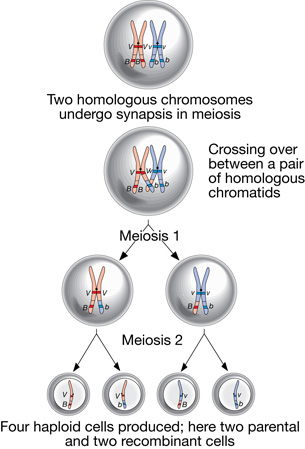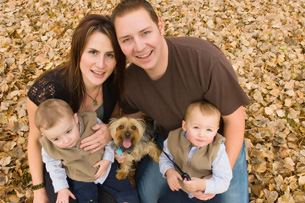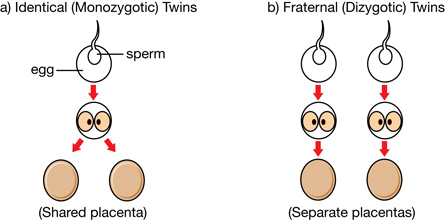Module 5
1. Module 5
1.18. Page 3
Module 5—Cell Division: The Processes of Mitosis and Meiosis
 Read
Read
Sources of Genetic Variation—Independent Assortment
Somatic cells in the process of dividing mitotically are made up of chromosome pairs with two sets of chromosomes. Think of each chromosome as being two chromatids. Originally, one chromosome of the pair came from the male gamete (sperm), and the other chromosome of the pair came from the female gamete (egg).
independent assortment: one of Mendel’s Laws of heredity (See the Lesson Glossary for a more detailed definition.)
Germ cells—in the gonads of both males and females—do not separate out the original chromosome sets; instead, new sets are formed. This is the first source of variation in meiosis and it occurs in metaphase I of meiosis. During the alignment of homologous pairs along the equator of the cell, each pair is free to arrange itself independent of others. This is known as independent assortment.

Consider the graphic shown here. It shows a cell with two pairs of homologous chromosomes. When the cell goes through meiosis, each alignment shown is equally likely. The end result is gametes with unique combinations. You can see that the shuffling is far greater in humans when you consider that human cells have 23 pairs, not just four! Read from “Sources of Genetic Recombination” on page 565 to the end of “Independent Assortment” on page 566 and examine “Figure 16.13” on page 566 of your text for another example.
 Watch and Listen
Watch and Listen
alleles: different versions (base sequences) of a gene or trait that will code for slightly different proteins (e.g., sickle cell hemoglobin versus normal hemoglobin)
Increased types of alleles in the gene pool increases variation and diversity and protects the species from extinction.
crossing over: an occurance during meiosis I when homologous pairs and their attached sister-chromatids form tetrads, entwine in synapsis, and may be chopped by enzymes into pieces
When chromosomes are reassembled, sections of the mother’s homologue may be exchanged with the father’s, forming chromosomes with new combinations of mother’s and father’s alleles. This increases variation in gametes and offspring, improving the species' chances of survival if the environment changes.
The previous diagram uses colour and size to clarify differences in chromosomes. The homologous chromosomes are the same size and have the same kinds of genes. They are different in colour to illustrate that they contain different forms of genes. These different forms are known as alleles.
Since there can be many alleles on each chromosome, it is common to represent alleles with letters instead of colour. So, an uppercase B and a lowercase b shown on a chromosome would be different alleles of the same gene (since they are the same letter). Homologous chromosomes have the same letter, but the case may vary. The significance of this practice of using uppercase and lowercase letters will be reviewed in a later lesson when you study the results of the potential crossing over of the parent generation.
To watch an animation of independent assortment, do an Internet search using the terms “independent assortment” + ”animation” + “shockwave.” Then, select “animation directory” and click on “independent assortment.” Use this animation to clarify the movement of homologous chromosomes and their letter assignment. You should also attempt the quiz at the end for a quick self-check.
 Read
Read

Sources of Genetic Variation—Crossing Over
Meiosis goes farther than simply shuffling the genetic deck—it actually makes new cards! Recall that during prophase I of meiosis the homologues pair up and form close groups called tetrads. Those groups are so close and so tight that sometimes small pieces from two neighbouring chromatids will break off and fuse with the other chromatid. This is known as crossing over, and it results in a chromosome with a gene combination never before seen. Read the description of crossing over on page 566 of your textbook and look at “Figure 16.14A.” As you can see, without crossover, there would be no chromosomes with an uppercase A and a lowercase b possible.
 Watch and Listen
Watch and Listen
Meiosis has three key components: reduction division, crossing over during synapsis, and the independent assortment of homologous chromosomes. “Unique Features of Meiosis” is a good summary of those features. Consider how the resulting gametes are different from their parent cell. You may wish to make summary notes, a flow chart, or a labelled diagram to summarize this information. Store this information in your course folder.
 Try This
Try This
TR 3. Although the end results of mitosis and meiosis are very unique, they do follow similar steps when it comes to sorting chromosomes. It is very important that you have a clear understanding of the differences between meiosis and mitosis. Using the search terms “Life’s Greatest Miracles” + “How Cells Divide” + “mitosis versus meiosis” review the animation showing a step-by-step comparison of mitosis to meiosis when starting with the same cell. Summarize the differences between these two types of cell division in a comparative table for your course folder.
 Module 5: Lesson 4 Assignment
Module 5: Lesson 4 Assignment
Retrieve the copy of the Module 5: Lesson 4 Assignment that you saved to your computer earlier in this lesson. Complete Part 1. Save your work in your course folder. You will receive instructions later in this lesson on when to submit your assignment to your teacher.
 Self-Check
Self-Check
For a meiosis tutorial and quiz, do an Internet search using the search terms “biology project + cell biology + meiosis + problems.” Then, select “meiosis tutorial” and choose the review notes or the “test yourself.” Each problem has hints and explains why a given answer is correct. If you need further clarification or help, ask your teacher.
 Read
Read

© Stephen Mcsweeny/shutterstock

Meiosis creates unique gamete cells. This important part of the human life cycle ensures variation within the human species. Given the incredible amount of variation that can result, how is it that identical twins exist?
Identical twins start from a single egg and a single sperm. Those gametes unite to form a single diploid zygote. As the zygote begins to divide through mitosis, a disruption may occur and cause the creation of two cell masses instead of one cell mass. At this stage, cells have not begun to specialize. Any cell is capable of becoming anything in the human body. They are known as totipotent. Since they have not specialized, and conditions are perfect for growth and development, each new mass grows to become a separate fetus. Since identical twins started from the same sperm and egg, they will be genetically identical.
totipotent: cells that have not specialized or differentiated (e.g., zygote, morula); all genes in the cell have the potential to be expressed (turned on)
Totipotent cells have the ability to form a complete organism.
Fraternal twins are a different story. They are the result of two different eggs being released at roughly the same time. During fertilization, each egg receives its own sperm nuclei, and the result is two separate zygotes. Each of these zygotes is genetically unique and no more related to its twin than it would be to any other brother or sister.